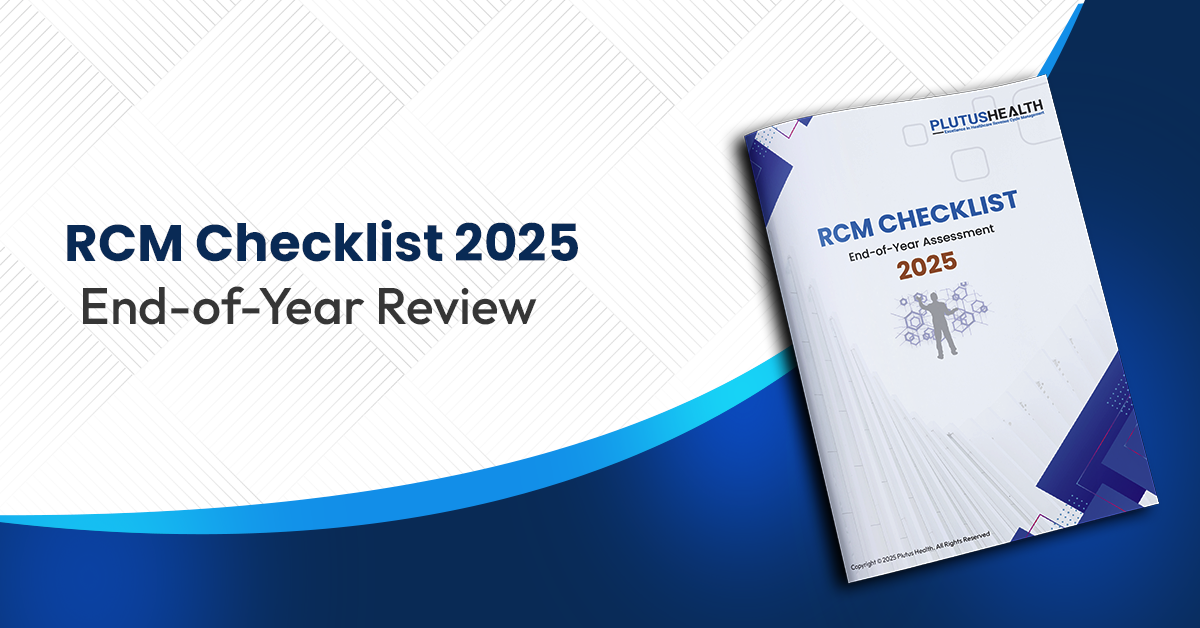The Top 5 Revenue Cycle Management Key Performance Indicators You Need To Track For Success
A solid revenue cycle management (RCM) strategy must track certain key performance indicators (KPIs) in order to understand patterns and optimize processes and flows.
If you manage your revenue cycle yourself or hire in-house office staff for the task, you know how tiresome and tedious it is to create a strategy that runs smoothly and efficiently. Not to mention, that having a weak process in place nearly guarantees touch point mistakes, leading to high rates of avoidable denials and rejections.
Consider the following KPIs as the vitals you need to track to ensure your revenue stream is healthy:
Days in Accounts Receivable
Tracking the days in A/R will reveal how long it takes you to get paid for your services on average. This information is critical in determining the efficiency in this particular point in your RCM workflow, as you’ll discover how long it takes your office to obtain payment for services.
How To Find this KPI: Divide the total A/R by the average daily net patient service revenue. (To get the average daily net patient service revenue, divide total annual sales by 365.)
Denial Rate
If you have a high rate of denials, you’ll need to put certain tactics in place to prevent future rejections, especially since our research shows that up to 90% of denials are avoidable. Document the reasons for denials and then put an action plan in place.
Example: Dr. Fields tracked the top 5 KPIs for his practice and discovered that he had a high rate of denials. After checking past claims and documenting the reason for denials, he realized that there were a high number of errors in coding. After spending a high cost for training material and professional development sessions to train his staff and implementing quality assessment checks on all postings, Dr. Fields’ denial rate was reduced.
Clean Claims Rate
Having a high clean claims rate fuels your practice’s cash flow, so it’s imperative to send out clean claims the first time around. This KPI will tell you whether or not the first touchpoints dealing with patient registration and insurance eligibility in your RCM flow is working accurately and efficiently. Even small mistakes in demographics or insurance information can result in a denial, so be sure to train your staff to quality check information before submitting a claim.
Pending Claims Rate
Check your current rate against last year’s rate. Has it increased, decreased, or remained the same? Your ideal rate is either low or steadily decreasing until you hit your goal. This KPI can give you information on your documentation, authorization, confirmation, billing, and respiratory teams.
Reimbursement Rate
Is your reimbursement rate improving month after month? If so, it means you’re ensuring that patients aren’t paying less than the contracted rates and your staff is properly trained to enter orders accurately the first time. If not, you’ll need to analyze these two touchpoints in your RCM workflow and optimize them.
Remember, it’s not enough to simply track these data points. After gathering the information, it’s important that you examine the data and find ways to strengthen weak points in your process and optimize it as much as possible.
The fastest, easiest, and most cost-efficient way to track these KPIs and optimize your process is by partnering with an outsourcing RCM solutions firm like Plutus Health.
Not only do our RCM experts create optimized workflows for practices and specialty labs, but we do it using Zeus, our robotic processing automation software offered as a service. Enjoy more time to focus on patients and more money when you save on overhead costs by allowing us to create an end-to-end RCM strategy that will track these 5 vital KPIs to increase the health of your revenue stream.
Connect with a Plutus Health representative today to learn how our rcm services can help your practice or lab eliminate human error, decrease overhead costs, and increase your revenue.
Liked the blog? Share it
FAQs


ABA providers are grappling with high staff turnover (up to 65%), rising burnout, administrative overload, and stagnant reimbursement rates. These challenges directly impact care continuity, clinical outcomes, and operational performance.


Operational inefficiency costs ABA teams up to 10 hours per staff member per week, contributing to burnout, denied claims, and longer accounts receivable (A/R) cycles. These inefficiencies ultimately result in reduced revenue and patient dissatisfaction.


Burnout leads to costly turnover, lower client retention, and decreased productivity. Recruiting and replacing a BCBA or RBT can cost up to $5,000 per hire, plus months of lost revenue and disruption to morale.


High-performing ABA organizations invest in clear career pathways for BCBAs and RBTs, align compensation with market benchmarks, and foster peer-led mentorship, flexible schedules, and wellness programs.


Automation tools like Plutus Health's Zeus streamline eligibility verification, denial management, and billing, reducing manual workloads by 5–10 hours weekly per clinician and improving clean claim rates by 95%.


Outsourcing revenue cycle management can improve collections, reduce denials by up to 30%, and free clinicians from billing-related admin tasks, resulting in better client care and financial outcomes.


One $200 million ABA network partnered with Plutus Health to automate eligibility and accounts receivable (A/R) processes. The result: $2M reduction in legacy A/R and a 97% Net Collection Rate.


By improving operational efficiency, investing in technology, and ensuring workforce stability, ABA leaders can align outcomes with reimbursement. Plutus Health supports this transition with scalable RCM and automation strategies.
FAQs


ABA therapy billing is the process of submitting claims to insurance or Medicaid for Applied Behavior Analysis services provided to individuals with autism or developmental disorders. It includes using correct CPT codes, proper documentation, and adherence to payer-specific policies.


Common CPT codes for ABA therapy in 2025 include:
- 97151 – Assessment and treatment planning
- 97153 – Direct therapy with the patient
- 97155 – Supervision and modification of behavior plan
- 97156 – Family adaptive training
- Always check with payers for any annual changes.


To bill Medicaid for ABA services, providers must ensure credentialing is complete, services are pre-authorized, and claims use the correct codes and modifiers. Medicaid requirements vary by state, so always follow state-specific billing rules.


Common ABA billing mistakes include:
- Incorrect or missing CPT codesplan
- Lack of documentation or treatment
- Uncredentialed providers rendering services
- Submitting duplicate or late claims


Without proper credentialing, providers can’t get reimbursed. Insurance and Medicaid require that BCBAs, RBTs, and organizations are credentialed and contracted. Delays in credentialing often cause revenue losses and claim rejections.
FAQs


CMS proposes a 2.4% increase in Medicare ASC payment rates, contingent on meeting ASCQR quality reporting requirements. Plutus Health helps ASCs meet these compliance benchmarks by integrating quality reporting data into RCM workflows, ensuring eligibility for full payment updates.


The ASC Covered Procedures List will expand by 547 procedures, including cardiology, spine, and vascular surgeries. Plutus Health supports expansion into new service lines by customizing RCM processes for high-acuity procedures, minimizing claim denials during the transition.


Site-neutrality narrows the payment gap with hospital outpatient departments, enhancing ASCs' cost-efficiency appeal. Plutus Health helps leverage this advantage in payer negotiations by providing performance dashboards and cost-justification analytics to secure stronger reimbursement terms.


Complex procedures increase denial risk and slow cash flow. Plutus Health's automation-first RCM model delivers 95%+ clean claim rates, reduces A/R days, and safeguards margins, even as your case mix becomes more complex.
FAQs


A hybrid RCM model combines in-house tasks like scheduling, intake, and patient communication with outsourced billing support for claims, denials, and A/R follow-up. Plutus Health enables this model with automation and expert teams.


Frequent CPT code updates, variable session lengths, high no-show rates, and sensitivity around patient collections make behavioral health billing uniquely challenging. Hybrid RCM helps strike a balance between compliance and patient care.


Tasks requiring patient interaction—like intake, eligibility checks, copay collection, and documentation—are best kept in-house, while backend processes can be outsourced.


Outsourcing denial management, claims scrubbing, and payment posting improves clean claim rates, reduces A/R days, and scales capacity without adding staff.


Plutus Health delivers 97%+ clean claim rates, AI-powered denial prediction, and 48-hour claim turnaround. Our hybrid RCM solutions provide behavioral health CFOs with visibility and control, while enhancing financial performance.
FAQs


Payment complexity, high out-of-pocket costs, increasing denials, and value-based care requirements are pushing providers toward more transparent, tech-supported payment systems.


Patients now act like consumers. They expect clear cost estimates, simple bills, digital payment options, and flexible financing.


AI, automation, and digital tools streamline estimates, reduce denials, support payment plans, and allow faster collections through mobile and online payments.


Complex billing questions, insurance confusion, and financial stress require a compassionate approach. Advocates guide patients and protect trust in clinical care.


Plutus Health supports providers with AI-driven denial prevention, predictive analytics, digital payment tools, patient financing, and a seamless platform, such as AnodynePay.


















































